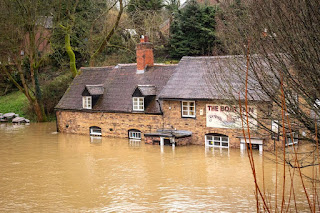The Drowned Children of Jackfield
The Drowned Children of Ferry Road, Jackfield.
The village of Jackfield lies less than a mile downstream
from Ironbridge, sitting on the River Severn’s southern bank. It seems quiet
now, but one doesn’t have to look far to glimpse the vast amounts of history in
the area. Like so much of Shropshire, it has played a pivotal role in
industrialisation, and provides a snapshot to a world at the advent of
industry. The village itself grew from the river port which served as a means
of crossing for nearby Broseley and Benthall. There has been an established
pottery there from at least 1634, and corn mills littered the stream that flows
into the river. It can even boast the first railway in Shropshire (and the
second in Great Britain) In 1605 the lord of the manor at nearby Broseley
constructed a wooden railway (known as a wagonway) from his coalmines to
the river at Jackfield. Perhaps Jackfield’s most famous contribution is the
Craven Dunnill Tile factory, which formed in 1872 and was to become one of
Britain’s leading producers of ceramic tiles. Known for their imitation
medieval designs, their encaustic tiles were used in buildings such as
Kemberton church In Shropshire, Chester and Shrewsbury Cathedral as well as the
London underground and even the houses of parliament. It was a leading employer
in the area, and now the buildings are part of the wonderful tile museum.
There are ghosts here, no doubt. I’m going to be discussing
some of them in due time, But as you walk around the area, they feel close
enough to touch. You can almost see them in their gardens or coming from the
riverbank, coracle in hand, or walking home after a long day of work, (or on
the way to the pub!) The past is alive here still, even if the old
inhabitants aren’t. This is the world our next story belongs to, a world its subjects
would have understood. I want to discuss a ghost story I’ve known since my
childhood- the drowned children of Ferry road. I want to retell the tale, and
also highlight the potential history behind it.
Ferry Road is part of ‘The Tuckies’
which lies in the eastern part of Jackfield. The whole area is still affected
by flooding and is very much at the mercy of the Severn. If you happen to be in the area, pop into The Boat
Inn, where the water flood levels have been recorded on the doorway for many
years now (but remember to bring your pennies as they don’t accept card). It
used to fascinate me as a kid. Much of this flooding occurs during the winter
months, creating a treacherous environment, and its during these winter months
our folk tale begins.
Our story concerns two local boys, who lived with their parents
in a cottage not too far from the Severn. They were twins- with a close bond
and would often play around the local area. One day, they were playing near the
spoil heaps of Craven Dunnill tile works when, the bank collapsed, taking the
poor boys with it. One version of the tale suggests one of the boys fell in
first, and his brother reached to rescue him, but was swept away too. The poor
boys didn’t stand a chance, their bodies were swept down river, and were taken
by the flood currents. It is said that they only resurfaced when getting caught
on a tree branch near the footbridge at Jackfield. When the boys didn’t return home,
the community rallied round and searched the area. The boys were found near the
bridge and were pulled out of the water, said to be still holding hands. The
bodies were taken to the first cottage on Ferry road, but it was unfortunately
too late to resuscitate.
It’s believed that the boys haven’t left Ferry road. Indeed,
there have been a number of reports of phenomena centred around the area, including
noises, cries, and full apparitions. The boys are often heard crying for their
mother all along the small road leading to the cottage their bodies were taken.
They are also frequently seen in happier times, playing, and laughing their way
down ferry Road. The sounds of crying and upset children are often heard near
the riverbank, and they’re also seen playing in some of the gardens of Ferry Road.
A further report states they’re seen in
the waters, splashing around as if playing a game and you can only tell they’re
not modern children by their ragged, old-fashioned clothes.
Without a doubt this is a very sad story, and to lose both
children in such a way would have been very traumatic for their families, and
also the wider area. Perhaps this trauma, and the shock of losing these boys
inspired reports of the ghosts. Residents of Ferry Road would have been all too
aware of the dangers of the river. Such an event as this drowning was common,
with a number of incidents during the 18th and 19th century,
some on a very large scale, such as the Ferry disaster of 1799- where 28 men,
women and children lost their lives when crossing the river from Craven Dunnill
after their shift. However, it would be wrong to suggest that this would make
the loss less profound. To lose someone prematurely, especially children would
have been a heart-breaking event, and the community- at this point of only 12
houses, would have carried that loss.
I was always told that the children lost their lives in the
1850s (some of the folk tales state 1852) however I have been unable to
find anything to suggest this, other than some of the folklore. Similarly, there are also accounts stating
that twin boys drowned in the 1840s, but I have met similar problems in
authenticating this as having occurred. This is not to suggest that such an occurrence
didn’t happen, perhaps the details have just been obscured by time.
Indeed, I recently came across an account from a lady named
Margaret Griffiths, which may uncover the origins of the ghost story. She
states that though there is no evidence of twin boys drowning, Her two sisters
drowned at Ferry Road in 1939. There was 12 months between them, (thus they would
have appeared similar in height and appearance) her sisters slipped whilst
playing and fell into the swollen river Severn. Interestingly for our ghost
story, the two girls were found on the riverbanks below the house, still
holding hands. Margaret believes that the two stories have hybridised, the
events of real life inspiring the folk tale we have today. I think this is a
very good point, as with many folk tales and ghost stories, they may change
from who is telling them, but they always contain a grain of truth, a reaction
to an event nearly otherwise forgotten. Even if there is no ghost children
haunting the little area of Ferry Road, the story is cautionary- imploring people
to respect the unpredictable nature of the river.
Jackfield, as it would have looked during the 1900s




Very interesting and poignant story.
ReplyDelete